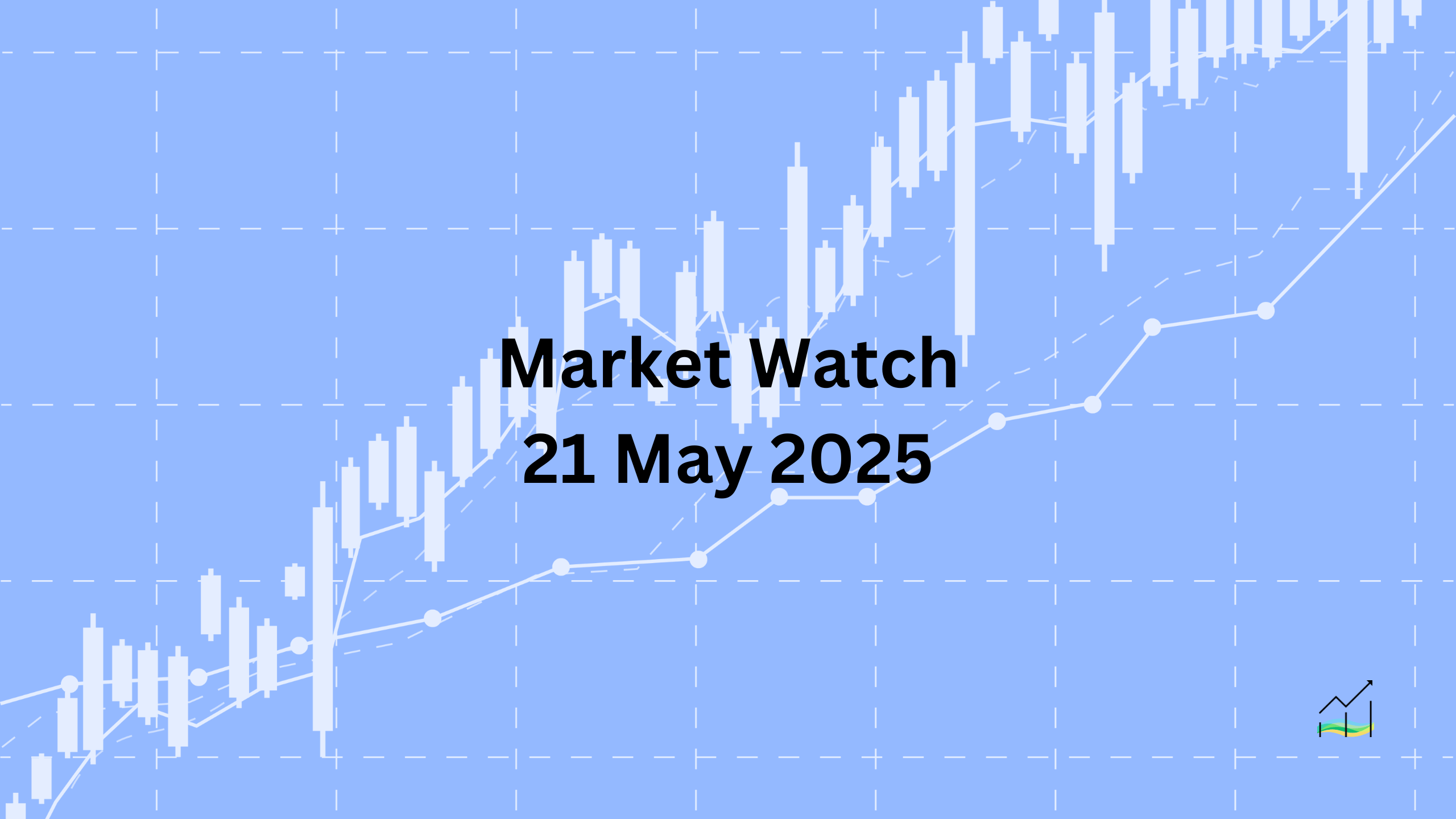21/05/2025 Market Watch

Geopolitical Risks Pressure Dollar as Markets Eye Bond Auction
Key Takeaways:
- The US dollar weakened against most major currencies, with risk-off sentiment dominating markets.
- Geopolitical tensions in the Middle East are lifting oil and gold prices.
- Equity markets show mixed performance; European and US indices face selling pressure.
- Bond yields rise despite broader risk aversion, diminishing their safe-haven appeal.
- Markets await demand signals from today's 20-year US Treasury auction.
The US dollar is under broad pressure following a retreat in the North American session. Risk aversion has gripped the markets, partially driven by reports suggesting Israel may be preparing for a potential strike on Iranian nuclear sites. This geopolitical uncertainty has fuelled a surge in crude oil, with July WTI reaching its highest level since early April. Despite the shift toward safety, the greenback has failed to benefit, while gold continues its sharp rise, touching near $3300.
In equities, sentiment remains mixed. Asia Pacific indices closed mostly higher, but the mood in Europe has turned cautious. The Stoxx 600 has broken a four-day winning streak, declining nearly 0.5%. In the US, the S&P 500 ended a six-day rally, and futures point to further losses, with contracts down around 0.75%.
Bond markets, typically considered a haven during periods of risk aversion, are not attracting strong demand today. Yields on European 10-year bonds have climbed by 6 to 8 basis points, while the US 10-year yield is up to 4.54%, just below Monday’s post-downgrade spike. With the US Treasury set to auction $16 billion in 20-year bonds, attention is turning to how the market absorbs this less-favoured maturity. The results may set the tone for the remainder of the week.
United States of America
Overview
The US dollar is struggling to maintain momentum after Monday’s rebound in North America, which had followed earlier selling pressure across Asia and Europe tied to Moody’s credit outlook downgrade. Despite briefly regaining ground, the greenback faltered again, dropping to a two-week low during early European trading today. Market sentiment appears cautious, with sellers quick to re-emerge on modest recoveries, highlighting the lack of sustained bullish conviction. The dollar’s near-term outlook remains fragile unless it can secure a close above the psychologically significant 100.00 level.
Economic Drivers
- Weak follow-through buying interest after Monday’s rebound suggests fading confidence in the dollar’s short-term prospects.
- Persistent concerns over US credit outlook following the recent downgrade by Moody’s continue to weigh on sentiment.
- Cautious global risk tone keeps the dollar vulnerable amid growing geopolitical uncertainty and mixed macroeconomic signals.
Data and Events
No major economic releases are scheduled today.
Price Action
- The dollar retreated to a two-week low near 99.40 before recovering to 99.80, where fresh selling emerged.
- Immediate support is identified between the 99.00–99.25 zone.
- A sustained close above 100.00 is needed to signal potential stabilization.
Key Points:
- Dollar failed to hold Monday’s recovery gains.
- Fell to lowest level in two weeks during early European trade.
- Sellers reappeared near 99.80, reinforcing short-term resistance.
- Support seen at 99.00–99.25, with upside capped unless 100.00 is reclaimed.
Canada
Overview
The Canadian dollar is trading near the lower end of its recent range, as market participants weigh softer headline inflation data against stronger-than-expected core readings. The loonie briefly touched CAD1.3880, moving below its 20-day moving average, and remains within a band established earlier this month.
Canada’s April inflation data surprised slightly. While headline CPI declined by 0.1%, largely due to the end of the carbon tax component, the annual inflation rate fell to 1.7% from 2.3%. Despite this drop, underlying core inflation remained elevated, with the average of the Bank of Canada’s preferred core measures rising to 3.15%, above the previous 2.85%. This has prompted markets to reassess the likelihood of a near-term policy easing, with expectations of a June rate cut now significantly reduced.
Equity markets have shown resilience, with the Toronto Stock Exchange Index extending a 10-day rally to reach new record highs. However, year-to-date performance remains relatively muted at just over 5%. This rally highlights growing investor confidence despite lingering uncertainty over the Bank of Canada’s next move.
Economic Drivers
- Headline CPI declined due to the removal of the carbon tax, contributing to a drop in the annual inflation rate.
- Core inflation unexpectedly rose, indicating persistent underlying price pressures.
- The inflation mix prompted a sharp reduction in rate cut expectations for June.
- Canadian equities have gained on optimism despite mixed inflation signals, reflecting stable investor sentiment.
Data and Events
No major economic releases are scheduled today.
Price Action
- The Canadian dollar fell to CAD1.3880, breaching the 20-day moving average near CAD1.3885.
- The currency remains within a trading range established since 12/05/2025 (CAD1.3895–CAD1.4015).
- The next support level is near CAD1.3850, corresponding to the 61.8% retracement of the recent rally.
Key Points:
- Headline CPI fell due to carbon tax removal, but core inflation was stronger than expected.
- Markets lowered June rate cut odds to around 25%.
- Canadian dollar remains range-bound, with support near CAD1.3850.
- TSX hit a record after a 10-day winning streak, gaining 5.3% year-to-date.
Japan
Overview
The Japanese yen appreciated sharply, driving the dollar to an eight-day low as trade-related tensions and disappointing trade data dominated the headlines. The greenback slipped below several key technical levels, briefly breaking below JPY144.00 before finding some support near JPY143.50. With weak demand for the dollar and fresh geopolitical considerations at play, market participants are cautious of further downside toward JPY143.25 or even JPY142.00.
Recent trade figures revealed Japan posted a deficit of nearly JPY116 billion in April, contrasting sharply with expectations for a surplus of JPY215 billion. Export growth slowed significantly, rising just 2% year-on-year, while imports declined by 2.2%. Over the past two years, Japan has accumulated a substantial trade deficit, though it maintains a sizable surplus with the United States. This imbalance is drawing renewed attention as trade talks with the US appear to have stalled.
US Treasury Secretary Bessent has warned that countries failing to negotiate in good faith over tariffs may face punitive measures as early as July. While Japan was the first to initiate dialogue, the lack of progress—especially over the inclusion of auto tariffs—has raised concerns. Domestically, Prime Minister Ishiba is facing declining approval ratings ahead of the upper house election scheduled for late July, further complicating Japan’s negotiating stance.
Economic Drivers
- April trade deficit of nearly JPY116 billion contrasted with market expectations for a surplus.
- Slower export growth and declining imports reflect weakening external demand.
- US–Japan trade talks are faltering, with Japan demanding broader tariff discussions.
- Rising political uncertainty ahead of July’s upper house election amid falling support for Prime Minister Ishiba.
- Ongoing risk of US tariffs under the April 2 “Liberation Day” threat adds pressure to Japan’s trade outlook.
Data and Events
- 21 May 2025: Trade Balance.
Price Action
- The dollar dropped to JPY144.10 and closed below the 20-day moving average and prior session lows.
- Briefly broke below JPY144.00 before rebounding near JPY143.50.
- Immediate support seen near JPY143.25; stronger support expected closer to JPY142.00.
Key Points:
- Yen strengthened sharply, pushing dollar below multiple support levels.
- Japan posted a surprise trade deficit in April, missing forecasts by a wide margin.
- Export growth slowed, and import demand contracted.
- US–Japan trade negotiations are faltering amid US tariff threats.
- Domestic political instability could weigh on Japan’s ability to negotiate.
United Kingdom
Overview
The British pound surged to its highest level in three years following a sharp rise in April inflation, bolstered by a warning from the Bank of England’s chief economist against premature easing. A spike in household utility bills drove the largest monthly increase in CPI in two years, pushing the index up by 1.2% — more than the entire increase recorded over the first quarter of 2025. Although the Bank of England may have initially looked past the headline jump, core inflation and services inflation also accelerated, complicating the outlook for monetary policy.
Core CPI rose to 3.8% year-on-year, up from 3.4% in March and 3.2% at the end of last year. Service prices climbed 5.4% over the past year, rising from 4.4% in December. These stronger-than-expected readings prompted markets to reduce expectations for near-term interest rate cuts. The swaps market now fully prices in the first cut for November, with total cuts for 2025 adjusted down to 36 basis points, from 45 basis points just a few days ago.
While inflationary pressures are heating up, signs of economic slowdown persist. The May flash composite PMI, due tomorrow, is forecast to remain below the 50-point threshold for the second consecutive month. This follows a full year in 2024 where the index remained in expansionary territory. The Bank of England now faces a more delicate balancing act between taming inflation and supporting weak growth.
Economic Drivers
- April CPI surged by 1.2%, driven by a sharp rise in household utility costs.
- Core inflation accelerated to 3.8% year-on-year, up from 3.4% in March.
- Service sector inflation climbed to 5.4% from 4.4% at the end of 2024.
- The Bank of England’s chief economist cautioned against cutting rates too soon.
- Markets reduced expectations for 2025 rate cuts in response to the inflation data.
- Growth outlook remains fragile ahead of the May flash PMI.
Data and Events
- 21 May 2025: CPI.
Price Action
- Sterling rose to a three-year high near $1.3470 before retreating slightly below $1.3400.
- Strong buying interest re-emerged below $1.3400, supporting the currency.
Key Points:
- UK inflation surged in April, with core and services prices accelerating.
- Sterling reached a three-year high before easing slightly.
- The BOE is now expected to delay its first rate cut until November.
- PMI data tomorrow will offer further clarity on UK growth momentum.
© 2025 SKONE Enterprise (003319453-V). All rights reserved.
The content on this site is for informational purposes only and does not constitute financial advice.


